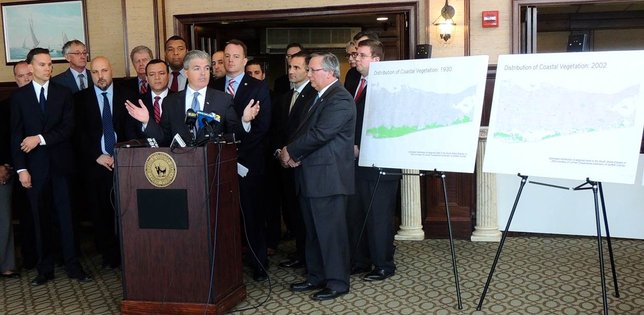Oakdale, NY - March 26, 2014 - Suffolk County Executive Steve Bellone announced today the first step in a comprehensive, multi-phased infrastructure plan to begin to address Suffolk County’s nitrogen pollution crisis. The ‘Reclaim our Water’ initiative would be the greatest investment in clean water infrastructure in generations.
“The alarming increase of nitrogen pollution from septics and cesspools in Suffolk County’s surface and ground waters is leading toward an ecological collapse,” said County Executive Steve Bellone. “Nitrogen pollution adversely affects our coastal resiliency, our environment, our economy, our land values, our tourism industry and our recreational use of our waters. We must take immediate and decisive action to remediate the decades of nitrogen pollution.”
“I want to thank County Executive Bellone for leading the most aggressive charge to fight nitrogen pollution in decades,” said Dr. Chris Gobler of the School of Marine and Atmospheric Sciences at Stonybrook University. “Nitrogen pollution of our bays has been decimating our coastal vegetation and it is time we took a stand.”
Woods Hole Oceanographic Institution, the largest independent oceanographic institution in the United States, released a study in 2012 that demonstrated that nitrogen pollution is the leading driver to wetland, sea grass and salt-marsh loss.
Governor Cuomo’s 2100 Commission Report, which included ways to improve the resilience and strength of the state’s infrastructure in the face of natural disasters and other emergencies, indicates that Long Island’s tidal wetlands play a critical role in protecting communities from storm damage.
Suffolk County Water Authority Chairman James F. Gaughran noted, “This is an important initiative that will begin to curb the damage that nitrogen pollution has caused in our waters.”
“We support County Executive Bellone’s efforts to invest in sewers that will help protect our water and provide for more local economic growth,” said Kevin Law, President and CEO of the Long Island Association.
According to the Cornell Cooperative Extension of Suffolk County, the South Shore estuary contains less than 10% of the coastal vegetation today that it had in 1930.
The funding to design the project, which will reduce nitrogen to the Forge River by almost seventy percent, was approved earlier this year. However, construction costs are estimated at over $300 million. This project will not be affordable without substantial federal and state support. I commend County Executive Bellone for recognizing our water quality problem and taking action to secure these much needed funds. I urge Governor Cuomo to approve Suffolk County’s application and make this sewer district a reality.”
Storm waves lose energy as they travel through vegetation, decreasing wave height and velocity by up to 80%. With no coastal vegetation to act as a buffer, storm waves strike coastlines at full force.
Coastal vegetation also prevents beach erosion by holding soil in place and counteracts flooding by storing water, approximately one million gallons for each acre of healthy marshland.
“70% of the nitrogen pollution in the Great South Bay comes from unsewered residential properties,” said Bellone. “Suffolk County has 360,000 unsewered homes, which is more than the entire state of New Jersey.”
County Executive Bellone stated that Suffolk County has identified three priority sub-regions to target for sewage upgrades: densely populated areas surrounding the Forge River, Connetquot River, and Carlls River.
Legislator Bill Lindsay said, “This is an extremely important issue not only to residents of 8th Legislative District but to all residents of Suffolk County.”
“The degradation of the Forge River sounded the water quality alarms in Suffolk County, and continues to be the poster child for Suffolk County’s sewering needs,” stated Legislator Kate Browning. “My efforts, along with strong community support, led to the creation of Maps and Plans and the completion of the necessary sewer feasibility study for this area. I commend County Executive Bellone for recognizing our water quality problem and taking action to identify and pursue funding sources.
“Sewering is potentially the most important thing we can do for the economic success of our downtown areas in Islip and throughout the County,” noted Islip Town Councilman Anthony Sentf.
“Babylon was greatly impacted by Hurricane Sandy,” said Antonio Martinez, Deputy Supervisor of the Town of Babylon. “I commend the County Executive and the Legislature for taking the lead on this comprehensive plan.”
Sewering these key areas, which contribute most to nitrogen pollution in the Great South Bay, will remove 3 million pounds of nitrogen from these tributaries over the next 10 years, amounting to a 25% reduction.
Suffolk County is pursuing state and federal funding for these infrastructure projects.
“The cost of sewering is too great to put the burden solely on the backs of Suffolk County residents,” said County Executive Steve Bellone.
The announcement comes at the heels of a recognition of the county’s water-quality initiatives. IBM named Suffolk County as a Smarter Cities Challenge grant recipient. Smartcitieschallenge.org is a competitive grant program that sends teams of some of IBM's most talented experts to select cities and regions worldwide to provide pro bono consulting expertise on the most critical issues faced by communities today.
This year, the company will be helping Suffolk County and at least 16 cities and regions around the world this year address issues ranging from clean water, healthy food, and revenue generation, to job development, efficient transportation and public safety.
More information is available on Facebook or SuffolkCountyNY.Gov.











